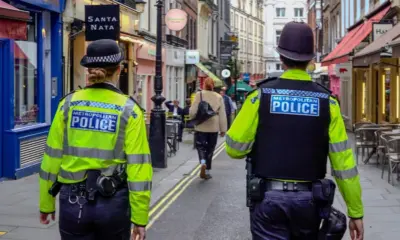Tech
Met Police Launches Smart Surveillance System Across London

The Metropolitan Police have introduced a new smart surveillance system across London in a major step toward modernizing urban policing and public safety. The initiative integrates artificial intelligence, facial recognition, and data analytics to enhance crime prevention and response efficiency. While officials emphasize the system’s role in improving security and reducing operational costs, civil rights advocates have raised questions about privacy, accountability, and the balance between safety and freedom. The rollout marks one of the most ambitious technology-driven public safety programs in the United Kingdom’s history.
How the Smart Surveillance System Works
The smart surveillance network connects thousands of cameras installed throughout the city to a centralized digital platform capable of real-time analysis. Using artificial intelligence, the system can identify suspicious behavior patterns, track vehicles, and flag persons of interest to law enforcement teams. The data is processed through secure servers managed by the Metropolitan Police, allowing for instant coordination between different departments.
Authorities say the system will significantly reduce response times and help officers allocate resources more efficiently. By integrating feeds from public spaces, transportation hubs, and commercial districts, the technology offers a comprehensive view of urban activity. The platform also supports predictive analytics, which helps forecast potential hotspots based on historical data. Officials describe it as a vital tool for combating organized crime, terrorism, and street-level offenses.
A key feature of the initiative is its adaptive learning capability. The software continuously improves as it collects data, allowing it to refine identification accuracy and reduce false alerts. The technology was developed in partnership with leading British universities and private cybersecurity firms, ensuring compliance with data protection standards. The system operates under strict regulatory oversight, with each use of facial recognition subject to internal and independent review.
Despite these assurances, the introduction of smart surveillance has sparked public debate. Critics argue that constant monitoring risks eroding privacy and civil liberties. They question whether existing legislation provides sufficient safeguards against misuse of data. The Metropolitan Police have responded by pledging transparency, publishing regular reports on system performance, and holding consultations with community groups to address public concerns.
Balancing Security and Privacy
Balancing the need for safety with the protection of personal freedoms remains a central challenge in modern policing. Proponents of the new surveillance system argue that it offers practical benefits for citizens by deterring crime and enabling faster investigations. They cite early pilot programs in central London, where the technology helped identify suspects in violent crimes and locate missing persons more efficiently than traditional methods.
However, digital rights organizations have urged lawmakers to ensure stronger oversight mechanisms. They warn that without clear boundaries, widespread data collection could create an atmosphere of constant surveillance. The Information Commissioner’s Office has emphasized that transparency, data minimization, and accountability must be the foundation of any technological expansion in policing. The success of the program, therefore, depends not only on its technical capabilities but also on the trust it builds with the public.
The government has expressed support for the Metropolitan Police’s initiative, framing it as part of a broader national strategy to modernize law enforcement. The Home Office views smart surveillance as a tool for preventing crime rather than merely reacting to it. Policymakers highlight that technology-driven policing is essential in cities as complex and populous as London, where traditional methods struggle to keep pace with evolving criminal tactics.
The system’s rollout also coincides with growing international interest in smart policing technologies. Cities such as Singapore, Tokyo, and New York are implementing similar models to enhance urban safety. The UK’s version is distinguished by its emphasis on ethical use and public accountability, although the long-term implications remain under scrutiny.
The Future of Policing in a Digital Age
The introduction of smart surveillance represents a broader transformation in how law enforcement operates in the digital age. The Metropolitan Police are investing not only in technology but also in training officers to interpret and apply data responsibly. The success of the system relies on human judgment as much as technological precision. Integrating artificial intelligence with policing practices requires continuous evaluation to prevent bias and ensure fair outcomes.
Future upgrades are expected to include the integration of drones, automated incident reporting, and real-time coordination with emergency services. Experts predict that these advancements could redefine the relationship between law enforcement and the public, making policing more proactive and data-driven. However, success will depend on maintaining strong ethical standards and legal safeguards to protect citizens’ rights.
Public acceptance will be crucial. Early surveys show that while most Londoners support measures that improve safety, many remain cautious about the potential misuse of surveillance tools. The Metropolitan Police have promised that privacy will remain a core consideration in system design and operation. Continuous dialogue between authorities, technologists, and civil society is expected to shape the program’s evolution.
Conclusion
The launch of the smart surveillance system across London marks a pivotal moment for the Metropolitan Police and the future of public safety in the city. By leveraging artificial intelligence and real-time analytics, the system has the potential to make policing more effective and responsive. Yet its long-term success will depend on transparency, accountability, and public trust.
As London becomes a model for technology-driven policing, the challenge lies in ensuring that innovation serves the people without compromising their freedoms. The coming years will test whether the city can maintain this delicate balance, setting a global example for ethical and effective law enforcement in a rapidly digitalizing world.




















